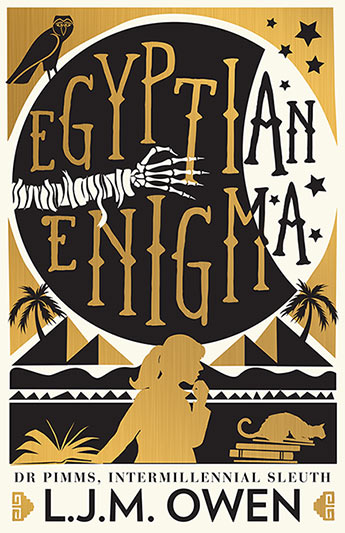Author: L.J.M. Owen
Publisher/Year: Echo Publishing 2018
Publisher Synopsis
Dr Elizabeth Pimms, enthusiastic archaeologist and reluctant librarian, has returned to Egypt.
Among the treasures of the Cairo museum she spies cryptic symbols in the corner of an ancient papyrus. Curiosity leads Elizabeth and her gang of sleuths to investigate a cache of mummies hidden in the Golden Tomb.
What is the connection between the Tomb and Tausret, female Pharaoh and last ruler of Egypt’s Nineteenth Dynasty? How did the mummies end up scattered across the globe? And is Elizabeth’s investigation related to attacks on her family and friends?
Between grave robbers, modern cannibals,misinformed historians and jealous Pharaohs, can Dr Pimms solve her latest archaeological mystery?
Reviewer: Isobel Blackthorn
The third in the Dr Pimms, Inter-millennial Sleuth cosy mystery series, Egyptian Enigma takes the reader deep into the exotic and ancient realm of the Pharaohs of Egypt. Engaging opening scenes of the prologue dive straight into the action of the story as Elizabeth Pimms visits a tomb in the Museum of Egyptian Antiquities in Cairo and catches a mysterious woman in her hotel room stealing her journal.
The narrative races back 4,000 years to Khemet and the reign of Pharaoh Seti II as his wife, Tausret prepares for her day. When her husband is assassinated, she takes control to become the last in her dynasty to rule Egypt and she is at risk at every turn. This parallel narrative is well-conceived and convincing, the reader provided an at once educative and fascinating insight into an ancient civilisation.
Meanwhile, back home in Canberra, the intrepid and wilful Dr Pimms and her team set about solving an archaeological mystery using modern techniques to see re-create a mummy. How Dr Pimm’s investigations and Tausret are connected is the key narrative driver.
The story is helped along by good characterisation of both the protagonist and minor characters,and a carefully devised and well-paced plot with numerous twists and turns. The reader is soon caught up in the blended family life of Dr Pimms and her professional life as both librarian and academic, with all of the ups and downs, arguments and tensions that come with such complexity.
The pace of the narrative is slowed considerably by both the archaeological exposition and descriptions of sumptuous dining. Yet these descriptive scenes help to provide Egyptian Enigma with a strong, cosy-mystery vibe. Themes of child brides, the subjugation of women and the deleting of women’s stories from the historical record are foregrounded to the delight of feminist readers.
The ending is abrupt and leaves many questions unanswered, leaving the reader waiting impatiently for Book Four. Overall, Egyptian Enigma will satisfy cosy mystery fans who enjoy being cossetted in a Miss Marple-style story world, L.J.M. Owen’s knowledge of archaeology coming into its own as ever it does in the Dr Pimms series.
